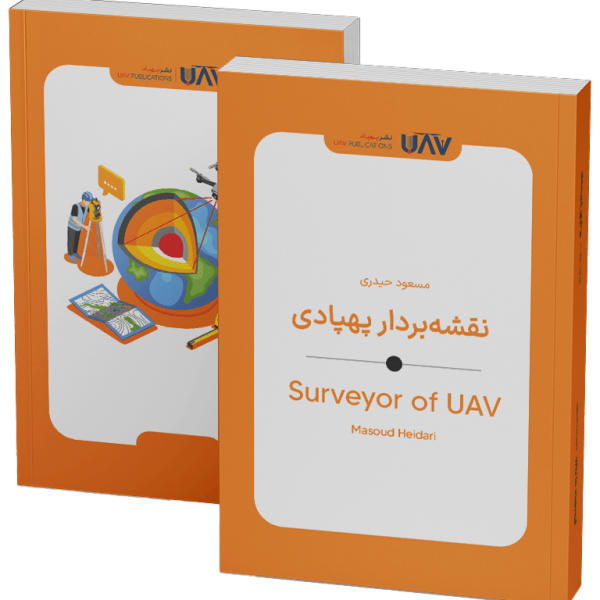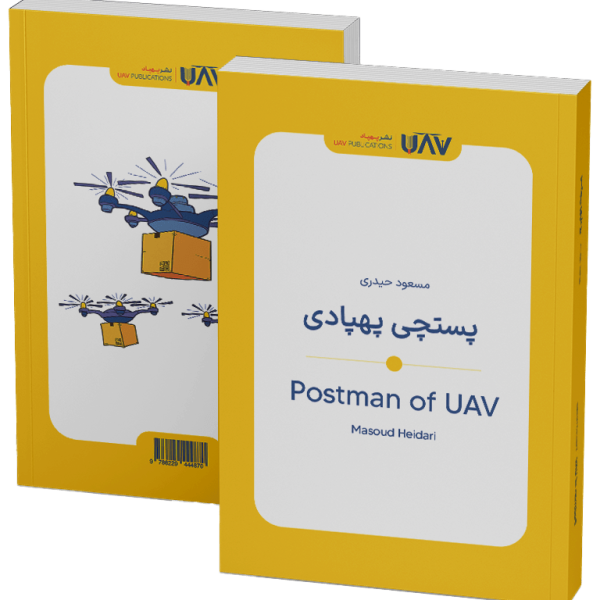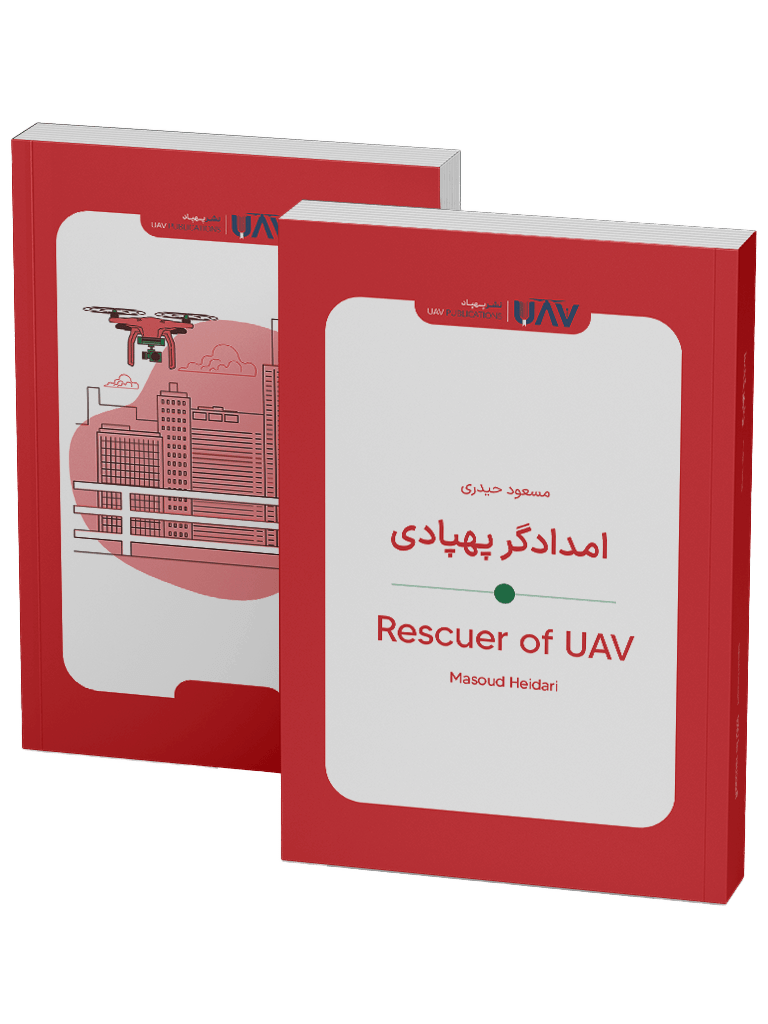Book – Rescuer of UAV
Rescuer of UAV, authored by Masoud Heidari and published by UAV Publications, is the first comprehensive and locally-authored work dedicated to the role of unmanned aerial vehicles in search and rescue operations. Written in a clear and scholarly style, this book explores the life-saving applications of UAVs in critical situations—from aerial reconnaissance and imaging to the delivery of emergency aid and environmental data analysis.
Rescuer of UAV is not merely a technical manual; it is a practical and inspiring guide for students, rescue workers, crisis managers, and all those intrigued by the life-saving technologies of the future. Read this book to discover how technology can be harnessed in service of saving human lives.
Introduction to the Book UAV Rescuer
UAV Rescuer is a pioneering, locally authored resource introducing the practical applications of unmanned aerial vehicles (UAVs) in search and rescue operations. The author presents, with clarity and thorough documentation, the crucial role of UAVs in saving human lives under critical circumstances. The book delves not only into the technical capabilities of drones but also offers a comprehensive exploration of their history, challenges, innovations, and future within humanitarian aid. Importantly, UAV Rescuer is focused entirely on civilian and human-centered applications. Its target audience includes students, researchers, technologists, emergency responders, and policymakers who seek to harness modern technology in the service of human life.
Why Was UAV Rescuer Written?
As outlined in the publisher’s foreword, the book aligns with the mission of UAV Publications: to provide educational materials that familiarize younger generations with emerging technologies and their beneficial applications. This book aims not merely to convey information but to inspire awareness and motivation, encouraging readers to gain a deeper understanding of a world where UAVs play an increasingly vital role.
The book’s central message is clear: UAVs are no longer just high-tech tools; they are integral components of life-saving systems. Understanding their function and potential is essential for anyone involved in emergency services, crisis management, or urban development.
What Is a UAV and How Does It Save Lives?
A UAV, or unmanned aerial vehicle, is a remotely piloted flying machine without an onboard human operator. These aircraft combine advanced engineering, artificial intelligence, wireless communication, and aerodynamic design to deliver capabilities once reserved for expensive manned aircraft. In rescue missions, UAVs can operate in areas where human presence is either dangerous or impossible.
Within minutes, they can reach disaster zones, transmit live data, monitor vast regions, and even deliver emergency supplies to those in need. These advantages have led many nations to adopt UAVs as standard tools in emergency response protocols.
Applications of UAVs in Search and Rescue
Drones are not limited to search operations—they support all stages of rescue missions. Initially, UAVs employ thermal or optical imaging to detect victims or assess damage. They then transmit real-time data to ground teams, enabling them to respond in an informed and timely manner.
In subsequent stages, some UAVs can carry and deploy relief packages, including water, medicine, food, or communication tools. Others may hover above sites to provide lighting, audio announcements, or serve as communication relays. This integrated approach significantly increases the speed and effectiveness of rescue efforts, particularly during natural disasters, wildfires, mountainous rescues, or urban catastrophes.
The Global Emergence of UAVs in Rescue Missions
Though the use of UAVs in emergency response is less than two decades old, its progress has been extraordinary. The first official deployment occurred during Hurricane Katrina in 2005 in the United States, where UAVs were used to assess flooded regions. The real turning point happened between 2010 and 2015, as battery technology, flight control systems, and sensors underwent significant improvements. Since then, drones have played a crucial role in major disasters such as the Nepal earthquake, Hurricane Harvey, and wildfires across California. This trend has rapidly spread, and today, most advanced countries include UAV units in their emergency response strategies.
The Benefits of UAVs in Rescue Operations
The advantages of UAVs in emergency response are undeniable. First, they provide rapid access to hard-to-reach areas—places that ground teams may require hours to access, and drones can reach in minutes. Second, UAVs offer real-time imaging and data, empowering commanders to make swift, informed decisions. Third, they enhance safety by entering hazardous environments on behalf of human responders. Other notable benefits include lower costs compared to helicopters, high adaptability, the ability to carry equipment, and performance under harsh weather conditions. Collectively, these features elevate drones from supplementary tools to core components of modern rescue operations.
Types of UAVs Used in Rescue
Not all drones are suited for rescue missions. UAVs for emergency operations are generally classified into three main types:
- Fixed-wing UAVs: Resembling small airplanes, these are ideal for long-range surveillance over vast areas but require substantial space for takeoff and landing.
- Multi-rotor UAVs: Such as quadcopter, which offer high maneuverability and the ability to hover in place. They are optimal for localized searches and light cargo delivery.
- Hybrid (VTOL) UAVs: Combining the strengths of both previous types, they can take off vertically and fly long distances. These are especially useful in complex, multi-phase operations.
Each type offers distinct advantages and must be selected based on mission-specific requirements.
Technologies Embedded in Rescue UAVs
Rescue drones are more than flying machines; they carry sophisticated technologies with specialized life-saving functions:
- Thermal imaging cameras: Detect heat signatures even through debris or in low-light conditions.
- LiDAR and multispectral sensors: Enable 3D mapping and detailed terrain analysis.
- Long-range communication systems: Transmit live data from areas lacking infrastructure.
- Spotlights, speakers, and payload modules: Provide direct aid to victims.
- Collision-avoidance systems: Use infrared, stereo vision, ultrasonic, and time-of-flight sensors to ensure safe navigation.
Together, these technologies transform UAVs from observation tools into active rescue agents.
Cutting-Edge Innovations in UAV Rescue Technology
Drone technology is undergoing a revolutionary transformation, with recent innovations including:
- Tethered drones: Connected to ground power for extended stationary flight.
- Advanced delivery systems: Featuring parachutes, retractable cables, or remote-controlled release.
- Swarm technology: Coordinated drone teams for simultaneous, expansive coverage.
- Modular payloads: Enabling rapid adaptation to various mission types.
- Waterproof and floating designs: Ideal for marine rescues and flood scenarios.
These innovations not only boost efficiency but also open new possibilities for life-saving interventions in complex environments.
Challenges and Limitations in Using UAVs for Rescue
Despite their benefits, UAVs face several hurdles in rescue operations:
- Restrictive or unclear flight regulations that delay deployment.
- Privacy concerns, especially in urban or emergency settings.
- Short flight times and limited payload capacity.
- Need for skilled, certified operators.
- Weather-related disruptions, including strong winds, rain, or dust.
- Complex coordination between aerial, ground, and command units.
The book addresses these issues comprehensively, offering practical solutions such as regulatory reform, targeted training, and the development of more resilient UAVs.
Skills and Traits of a Professional UAV Rescuer
Operating drones in rescue missions requires more than basic piloting. A professional UAV rescuer must:
- Pilot drones under challenging conditions.
- Understand emergency flight laws and protocols.
- Design and execute search missions.
- Analyze thermal imaging and sensor data.
- Be trained in first aid and rapid response.
- Communicate effectively with rescue teams.
- Conduct UAV maintenance, troubleshooting, and repair.
This multidisciplinary role blends engineering, emergency response, media, and humanitarianism—each element carefully explored in the book.
Legal Frameworks and UAV Rescue Certification
Operating drones in rescue work is not only a technical endeavor but a legal and ethical responsibility. In many countries, official certification is mandatory, verifying both flight competence and awareness of emergency procedures, airspace regulations, and privacy rights. In real-world missions, UAVs must operate in alignment with national disaster management systems. This requires familiarity with emergency protocols, no-fly zones, night-time operations, and beyond visual line-of-sight (BVLOS) regulations.
While Iran’s civilian UAV regulatory framework is still evolving, there is an urgent need for dedicated legislation governing the use of UAVs in rescue operations. The book underscores the importance of “legal compliance with operational urgency”—a principle that becomes vital in times of crisis.
How UAVs Will Transform the Future of Rescue
Drone technology shows no sign of slowing, and emergency response is one of the sectors most profoundly impacted. Shortly, we can expect:
- 5G-enabled UAV networks delivering real-time imaging and data on a national scale.
- Drone swarms are performing coordinated, simultaneous search missions across multiple regions.
- AI-powered flight systems are handling complex missions autonomously.
- Innovative delivery systems ensure timely aid without human intervention.
- Specialized models for underwater rescue, high-altitude terrains, and hazardous zones.
Supported by statistics and real-world examples, the book demonstrates that drones are no longer auxiliary tools—they are indispensable members of the rescue team. A future empowered by this technology could save countless lives.
Why You Should Read This Book—and Take Drones Seriously
UAV Rescuer is far more than a technical manual or information compendium. It is a remarkable attempt to illustrate the intersection of technology, humanitarianism, and social responsibility through an accessible and research-based lens. With clear language and credible references, the author introduces readers to the expanding world of rescue UAVs. Whether you’re a student, disaster manager, city official, emergency responder, or tech enthusiast, this book serves as an educational and inspirational guide. It offers specialized knowledge, strategic insight, and a profoundly human perspective on the mission of saving lives.
In a world increasingly shaped by crisis, understanding how technology can be wielded in defense of humanity is not optional—it is essential. UAV Rescuer provides a precise roadmap for navigating that path.
| Book Author | |
|---|---|
| Book Edition |
First |
| Book Isbn |
978-622-94448-3-2 |
| Book Pages |
66 |
| Book Language | |
| Book Publish Year | |
| Book Publisher |



